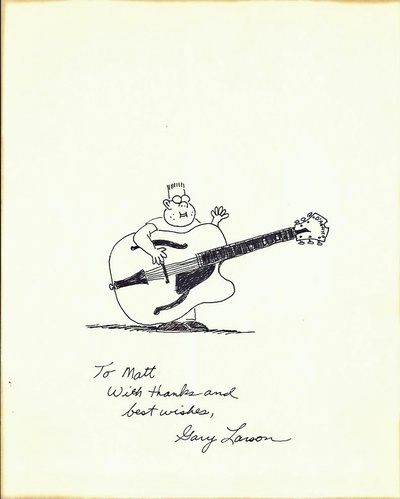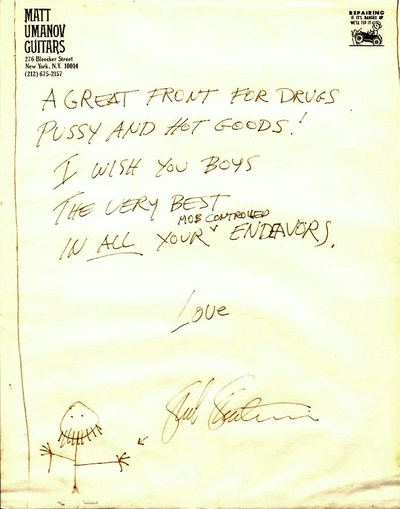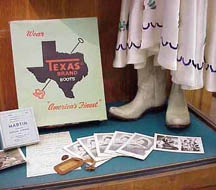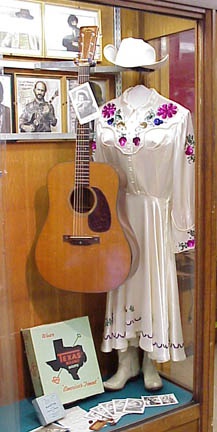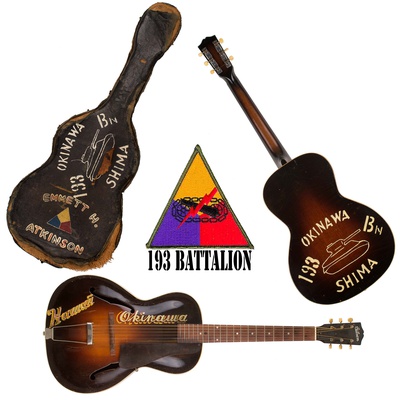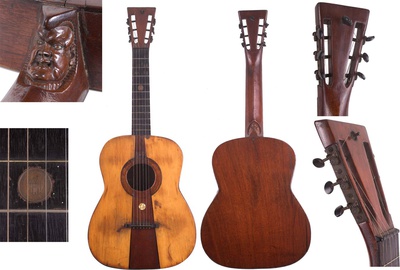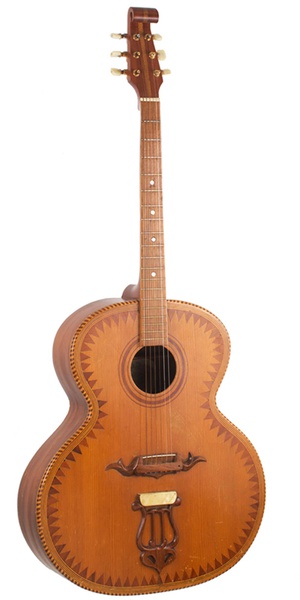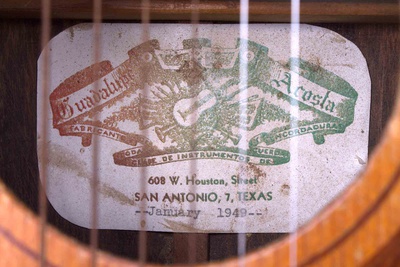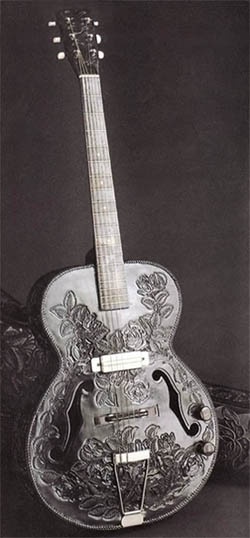
Cartoons by Robert Crumb, Gary Larson & Shel Silverstein
From 1969 through 1977, the location of our very first store was at 35 Bedford St., right here in the West Village and not more than three blocks from where we are now, but on a tiny backwater street; you had to know about us to find us, and plenty of people did, from local beginning players to working pros, to Bob Dylan, George Harrison, Yul Brynner, Steve Martin, and plenty more. Robert Crumb, the internationally-known cartoonist famous for his "Keep On Truckin’"drawings and Zap Comix, was a frequent visitor. He was also known for making drawings on the spot in places all over the world to trade for instant merchandise, and I was an occasional victim, as in the drawing here, which he offered to do immediately after asking for a few sets of strings. How could I say no? He asked for some paper and I gave him a piece of our stationery, on which, in a minute or two at most, he drew a picture of his famous Mr. Natural character with the thought balloon “Nobody’s gettin’ rich”, which had been my reply after he asked me how business was. I framed it, still have it, displayed here in my store.
Gary Larson, the world-renowned syndicated cartoonist of “The Far Side”, visited us many times at our current location, which we’ve been at since 1982. He was a player and a fan of carved-top jazz guitars, especially those of Jimmy D’Aquisto, who many consider to be the greatest builder ever of these instruments. Jimmy had been a very close personal friend of mine since the 1960s (he died in 1995), and Gary owned at least one of his guitars, which Gary(?) is caricatured holding in the drawing shown here. He gave it to me, as I recall, in gratitude for having set up, or possibly repaired, one of his most treasured instruments, possibly a D’Aquisto. I framed it, still have it displayed in my store today.
Shel Siverstein…….what can I say? Many of you know of Shel from the hugely popular, to this day, children's’ books he wrote and illustrated, such as The Giving Tree, Where the Sidewalk Ends, and so many more. A few of you may know of his relationship with Hugh Hefner, publisher of Playboy; they were both from Chicago, they were friends, and Shel often wrote articles for the magazine, did cartoons for it, and was a frequent guest at the Playboy Mansion. I’m always surprised, however, that so many people today have no idea of all the hit songs, mostly in the C&W vein, that Shel wrote: A Boy Named Sue; The Cover of the Rolling Stone. Marie Laveau; Sylvia’s Mother; Put Another Log on the Fire; One More on the Way; The Queen of The Silver Dollar; and countless more. Shel had homes in several places including Chicago, Key West, Hong Kong, and a few blocks from here in Greenwich Village. Being a musician, and a writer, and a guy with great curiosity and someone who made his own time, when he was at his New York home he frequently came in here to hang out, to try out new songs on us (example: an out-of-work hooker singing "I’ve Got to Get Back on My Back to Get Back on My Feet”, never published or recorded far as I know), and to shoot the occasional breeze, sometimes the two of us just hanging out on the sidewalk in front of my store as we watched the world go by. So……..would seem that one day I must’ve asked him to do what R. Crumb had done, make me a drawing, and Shel, not exactly being shy, did what you see here. I will also say though that when the time came to clear out some stuff from his Village apartment, he came by one day and gave me his collection of Delmore Brothers LPs, which I still have and treasure. Shel was a man of many refined tastes and great personal charm; when he was engaged in a conversation with you no one else in the world existed for him. We miss him dearly.
Linda Gaye
About fifteen years ago, we acquired a 1947 Martin D-18 that had belonged to a woman, one Linda Gaye by name, perhaps from somewhere in the mid-west, whose lifelong dream had been to become a Country & Western star. She got the guitar; she got the dress (which she even may have made herself); she got the boots and she got the hat; she had picture-card giveaways made up, which she autographed, with her shining, smiling face on them; but as far as we know, she never rose to the the fame and stardom that that had so excited her as a hopeful young performer. When we got the guitar, along with it came all the accoutrements of her dream; she even saved the original box that the boots had come in. We set up what I consider to be the very finest display we ever had here, which you can see in these photos. I wish i had recorded just who it was that bought this complete outfit and where it went; if anyone out there knows, or knows of it, I surely would appreciate hearing from you.
Okinawa
Years ago, back maybe in the 1940s and '50s, it was not uncommon for aspiring country music performers to have their stage names painted on the front of their acoustic guitars, usually by a local sign painter, most of whose daily work might be making paper signs for the windows of local groceries, announcing things like "SALE! Watermelon only 10c/lb. this week!!". It was often done in what I think is called shadow lettering, quickly accomplished with an artistic flair and a very sure hand, and tossed out shortly after its usefulness expired. I've come across a few guitars over the years that had the names of long-forgotten performers painted on them. One was an early-50s Gibson J-200 that said "Plowboy Smokey", in large script, around the edge of the top. It was bought by Billy Idol and far as I know has long since been lost to obscurity. Another was a 1960s Gibson B-25N that had "Cowboy Jack" in beautiful red script. We had it on display in the store when Daryl Hall walked in one day, said "That was my secret name for myself when I was a kid!" and bought it. He still has it.
The guitar shown here is a late-1930s Gibson L-75, which had belonged to a GI who was serving in occupied Japan right after WW II. "Okinawa" and"Hawaii" are beautifully done on the front. His tank Battalion number and logo are on the back and on the case, though apparently by a different hand.
This is a dying art in our world of today, superseded by computers and a lot of other things, but there are still a few who practice it. One of them is local to us, Lawrence El-Amin, a Michigan native transplated to New York years ago, and we have him make window signs for us whenever we're having a special sale or event. Somehow, the world of guitars, and guitar players, and our American music in general just seem to go perfectly with traditional art forms like this, and we love every bit of it.
Union Forever 1864
This is one of the more unusual and mysterious pieces in my "accumulation", as it were, of instruments that people used to bring in to my store to sell in the days before the Internet. I'd say that while it was not made by a professional guitar maker, it certainly was made by someone with more than the average of woodworking skills. It's a bit lumpy, and utterly charming. It has seven tuning pegs, which I'd say are of mid-late 19th-century manufacture; two 3-on-a-side strips and one banjo patent peg, though the bridge, which is obviously a later replacement, has only six slots in it. Now for the best parts: There is a coin-like brass token inlaid into the fifth fret of the unusually short neck, which has on it a US shield and the words "UNION FOREVER 1864". I don't know the original reason for these Civil War era tokens having existed but they're not that uncommon in the coin-collector world. Was the guitar made in the 1860's? Do its seven strings indicate that it was made by or for someone who played Russian music? (Seven-stringed guitars are a true Russian thing). And now the very best part, In my opinion: The heel of the neck has got a full-relief face carved into it, almost like a man-in-the-moon face, with little real glass eyes, almost like something that might've been intended to be used by a taxidermist of small birds. And they stare at you. As for the rest of the guitar, it's a bit crude, but again, so charming. The peghead leans to one side some and both it and the entire body are kinda unevenly shaped; it has mahogany back, sides, and HUGE triangular neck, but the top and fingerboard are best described as being made from mystery wood. The edge around the back has been tacked down with little nails. Maybe a later "field repair"? Maybe original? Who could say? This is almost what I'd call folk art but not quite. It's a unique, wonderful, mysterious guitar made by some individual who we'll probably never find out anything about. Not even on the Internet.
The Legendary & Celebrated Texican
I saw this guitar at a vintage show several years ago, was stopped dead in my tracks. As you might know, these shows are largely filled with Strats, Teles, Les Pauls, and mostly being displayed by folks who are part-time dealers, don't really have stores, but are having a lot of fun being in the midst of all that stuff for an entire weekend. A fair number of vintage acoustics in well, maybe not-so-hot condition will show up, but usually not much else in that arena. I go to these shows mostly to buy for my store, and am so happy when on rare occasion I see something that actually gets me excited. Doesn't happen much anymore since the number of people who are prone to find, let alone bring to shows, cool weird old stuff has dwindled dramatically in recent years.
Anyway, same guy had this on his table for five or six consecutive shows, a few years' worth. He who has a store in California and knew of me, knew I dearly loved the guitar every single time I passed it by, and he really appreciated what he had as well. Every six months or maybe once a year, he'd implore me to buy it just so it would find a good and appreciative home, but I don't indulge myself with "emotional buys" the way I used to. Finally, maybe last Texas or Philly show (can you imagine him carrying this thing around for all that time? He really loved it too), he caught me on the floor, said make me any reasonable offer, it's yours. I said it can't be reasonable, he said I don't care, you really should have this guitar, and I bought it.
So.......I'm finally playing this thing, sounds to me like all of Mexico, Mexican guitar making, and Norteno music rolled into one, a guitar and a guitarron combined if you will (the body is 19" across!) and I bring it back, show it around to the crew for a few days; I'm in love. A particular salesperson on staff, of Mexican descent a few generations back, who had grown up in Princeton NJ where his dad is a doctor, says one day "Ya know the name on the label sounded familiar so I asked my mom, and she told me that the guy who made it (label says Guadalupe Acosta / San Antonio Texas / January 1949) was her uncle's brother-in-law, used to come around the house all the time". There you have it; what goes around, comes around. Amazing. The other best part is that unlike some of that "fancy" stuff that we often see up North, the workmanship here is prime, neat and clean throughout the entire guitar and to a "T" on every single piece of marquetry. And that bridge! Caramba!! Sigh...............
Bulldog's Guitar
Here’s one for the books. I first saw this guitar at a vintage show in Florida more than ten years ago, and contemplated it some; actually, I had a bad case of the “wants” just for its look and wildness, but couldn’t bring myself to spring for it. Monetary resources had to be parceled out carefully that weekend, no room there for “personal buys,” and I decided to pass, but boy, did I want it. Regretted it later, but felt I had to marshal my funds at the time, no choice. A year later, I’m back at the same show, same city, and there’s the same guy sitting at the same table, with the same guitar. This, I said to myself, is more than a sign: it’s written. So I start talking to the seller, see if I can get any kind of story from him, since “the story” is always such a big part of something that unusual, and he did indeed have one for me. Seems that he had gotten the guitar from his uncle, who just didn’t want it anymore, had no use for it. His uncle in turn had gotten it from a childhood friend who, as a young man, had borrowed some money from said uncle back in the late 1940s, maybe early ‘50s, in Michigan, where they lived. The friend, who went by the name of Bulldog, was shortly thereafter arrested for murder, convicted, and sent to the Southern Michigan State Penitentiary to contemplate his transgressions for a very long time.
Cut to about twenty-five years later and uncle gets a surprise visit from Bulldog, who has now been released after having seen the error of his ways. Bulldog, feeling great remorse at this point for having borrowed money which he had never repaid and still couldn’t repay, offers to give his guitar and its case, both of which he had spent the last twenty-five years totally covering in hand-tooled black leather, to uncle as restitution. They are TOTALLY covered, front, back, and sides a la Elvis, Waylon, and other ‘50s country music stars, with gorgeously done floral patterns, leaves, and vines, and the quality of the work is absolutely top-notch. This isn’t your amateur prison-style work: it’s highly professional, of a kind found only on the very best saddles, holsters, belts, etc. Uncle accepts, years later gives it to his nephew, who eventually sells it to me, and there it is, except I have one question: how did Bulldog ever convince those prison officials to let a convicted murderer have possession of all those sharp tools for all those years?
Photograph by John Peden
Matt's "Collection"
Matt's Collection isn't really a collection at all; it's more like an accumulation. Forty-some-odd years of being around fretted (and some unfretted) stringed instruments has led to crossing paths with more than a few oddities, and odder-than-oddities, and when something calls out to you and says "please take me home", there's just no disregarding that call. Fortunately, this has happened to me many times over the years, and I've managed to acquire some wonderful pieces. Some look fabulous, some look strange, and every single one of them has a terrific story, known or not. None of these pieces are for sale; they're far too personal to me, and besides, I suspect that the sum total "worth" of them isn't much more than about twelve bucks in money, but in terms of what they are, each and every one of them is, as they say, priceless.






